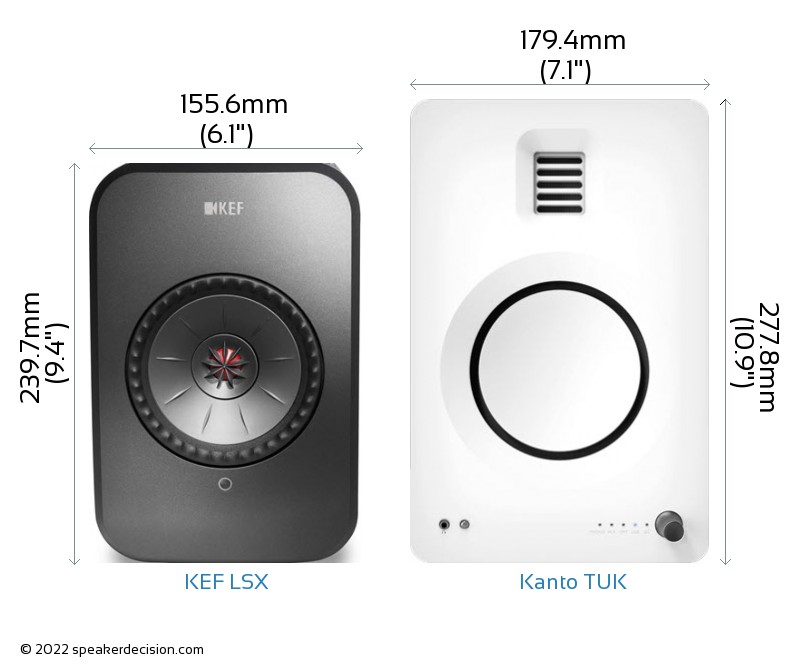In this review, we will be comparing LSX and TUK, two Powered Bookshelf speakers from KEF and Kanto. Being Powered speakers, they both have built-in amplifiers so you don't need an external power amp or an integrated amp to power them.
Let's have a brief look at the main features
of KEF LSX and Kanto TUK first before getting into our more
detailed comparison.
KEF LSX Key Specs
- 2-way Design
- 200-watt RMS Integrated Amplifier
- 0.75" Hard-Dome Tweeter
- 4.5" Magnesium/Aluminium alloy Woofer
- 59-28k Hz Frequency Response
- 24-bit Max Depth / 96 kHz Max Sample Rate
- Built-in 4.2 Bluetooth
- App Control Feature
- Weight:3.50kg
- Dimensions (H x W x D): 239.7" x 6.125" x 7.1"( 239.7 x 155.6 x 180mm )
Kanto TUK Key Specs
- 2-way Design
- 130-watt RMS( 260-watt Peak) Integrated Amplifier
- 1.0625 x 1.375" AMT Tweeter
- 5.25" Aluminum Woofer
- 50-20k Hz Frequency Response
- 24-bit Max Depth / 96 kHz Max Sample Rate
- Built-in 4.2 Bluetooth
- Weight:4.50kg
- Dimensions (H x W x D): 277.8" x 7.06" x 10.9"( 277.8 x 179.4 x 276.2mm )
In the following sections, we will get into more detail in order to better understand how the KEF LSX and Kanto TUK compare and hopefully end up with enough arguments to decide which one of these loudspeakers is the better choice for you.
**This post contains affiliate links, and I will be compensated if you make a purchase after clicking
through my links. As an Amazon Associate I earn from qualifying purchases.
Drivers
Both LSX and TUK are 2-way speakers.
| Driver |
KEF LSX |
Kanto TUK |
|
Driver Setup
|
2-way
|
2-way
|
|
Tweeter
|
0.75-inch
|
1.0625 x 1.375-inch
|
|
Midrange
|
- |
- |
|
Woofer
|
1 x 4.5-inch
|
1 x 5.25-inch
|
LSX features a 0.75" Aluminum Hard-Dome Tweeter and 1 x 4.5" Magnesium/Aluminium alloy Woofer . On the other hand, the TUK features a 1.0625 x 1.375" Folded ribbon AMT Tweeter and 1 x 5.25" Aluminum Woofer .
Frequency Response
LSX has a frequency range of 59-28k Hz whereas TUK has a frequency range of 50-20k Hz. With a minimum frequency of 50Hz, the TUK can go significantly deeper on the low side and provide stronger bass compared to the LSX's min frequency of 59Hz.
Below graphs depict how these two speakers compare with the max, min and average values of the Min and Max Frequencies of other speakers in the Bookshelf class in our database.
Low Frequency
Bookshelf Speakers
High Frequency
Bookshelf Speakers
None of these speakers achieves full range experience which is commonly agreed as 20Hz-20kHz. In order to achieve lower lows / deeper bass, we recommend you pair these with a subwoofer. Visit our Powered Subwoofers section to find out more about the available options.
Physical Specs
Size of a speaker can sometimes become an important decision factor due to space constraints or in some cases purely for esthetic reasons. In this section, we are going to compare KEF LSX's and Kanto TUK's external dimensions. KEF LSX has external dimensions of 239.7 x 155.6 x 180mm ( 9.4375 x 6.125 x 7.1inch) whereas Kanto TUK has external dimensions of 277.8 x 179.4 x 276.2mm ( 10.9 x 7.06 x 10.9inch) .
Kanto TUK is clearly the larger of the two speakers. Its body is 23.8mm wider, 38.1mm taller and 96.2mm deeper than KEF LSX.
Below you can see the front view size comparison of KEF LSX and Kanto TUK in scale.
 Comparison image of KEF LSX and Kanto TUK Size and External Dimensions
Comparison image of KEF LSX and Kanto TUK Size and External Dimensions
Base Surface Area Comparison
Base surface area of a loudspeaker may become a determining factor when the space in your room or desk is limited.
The base surface area of the KEF LSX is approximately 365.7cm2 / 56.7inch2 and base area of the Kanto TUK is approximately 495.5cm2 / 76.8inch2. The LSX requires 26% less surface area than the TUK which gives it a small advantage on placement in tight spaces.
Here is an another comparison that shows both speakers on a BDI Octave Media Cabinet, next to a standard size amplifier and turntable in scale:
 Size Comparison image of KEF LSX and Kanto TUK on a Media Console
Size Comparison image of KEF LSX and Kanto TUK on a Media Console